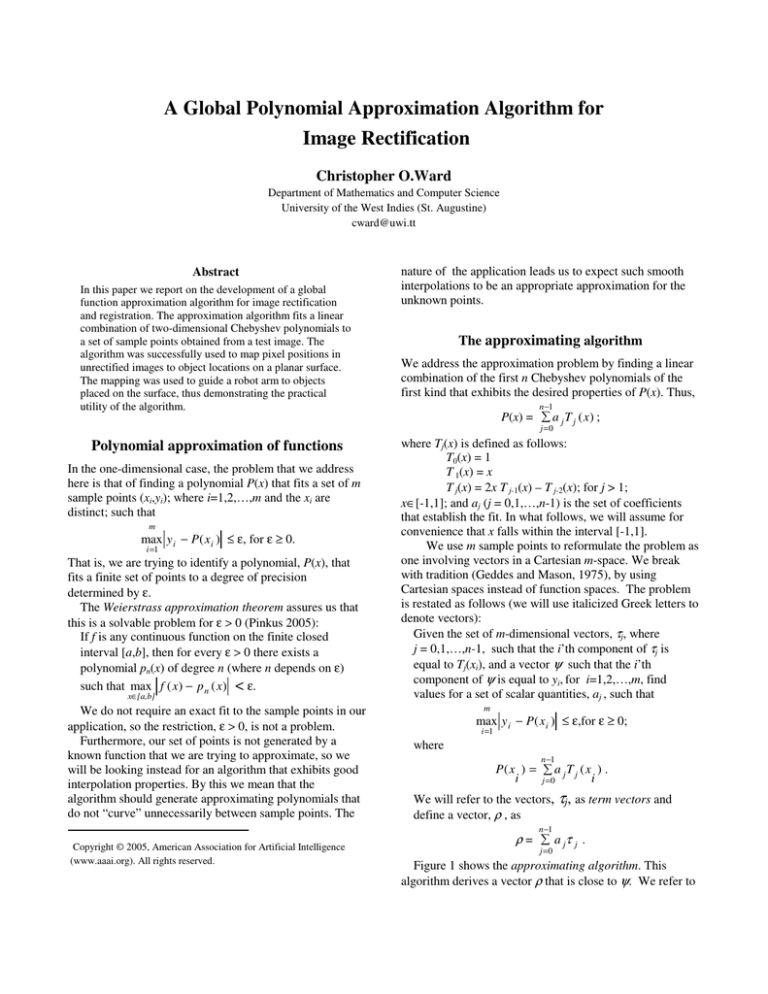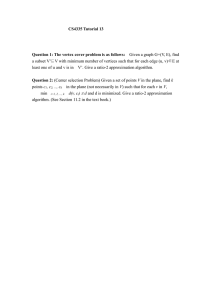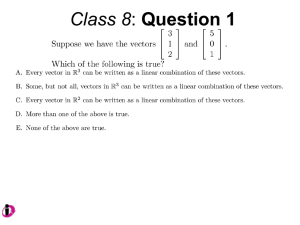
A Global Polynomial Approximation Algorithm for
Image Rectification
Christopher O.Ward
Department of Mathematics and Computer Science
University of the West Indies (St. Augustine)
cward@uwi.tt
Abstract
In this paper we report on the development of a global
function approximation algorithm for image rectification
and registration. The approximation algorithm fits a linear
combination of two-dimensional Chebyshev polynomials to
a set of sample points obtained from a test image. The
algorithm was successfully used to map pixel positions in
unrectified images to object locations on a planar surface.
The mapping was used to guide a robot arm to objects
placed on the surface, thus demonstrating the practical
utility of the algorithm.
Polynomial approximation of functions
In the one-dimensional case, the problem that we address
here is that of finding a polynomial P(x) that fits a set of m
sample points (xi,yi); where i=1,2,…,m and the xi are
distinct; such that
m
max y i − P ( x i ) ≤ ε, for ε ≥ 0.
i =1
That is, we are trying to identify a polynomial, P(x), that
fits a finite set of points to a degree of precision
determined by ε.
The Weierstrass approximation theorem assures us that
this is a solvable problem for ε > 0 (Pinkus 2005):
If f is any continuous function on the finite closed
interval [a,b], then for every ε > 0 there exists a
polynomial pn(x) of degree n (where n depends on ε)
such that max f ( x ) − p n ( x ) < ε.
x∈[a,b]
We do not require an exact fit to the sample points in our
application, so the restriction, ε > 0, is not a problem.
Furthermore, our set of points is not generated by a
known function that we are trying to approximate, so we
will be looking instead for an algorithm that exhibits good
interpolation properties. By this we mean that the
algorithm should generate approximating polynomials that
do not “curve” unnecessarily between sample points. The
Copyright © 2005, American Association for Artificial Intelligence
(www.aaai.org). All rights reserved.
nature of the application leads us to expect such smooth
interpolations to be an appropriate approximation for the
unknown points.
The approximating algorithm
We address the approximation problem by finding a linear
combination of the first n Chebyshev polynomials of the
first kind that exhibits the desired properties of P(x). Thus,
P(x) =
n −1
a j T j ( x) ;
j =0
where Tj(x) is defined as follows:
T0(x) = 1
T 1(x) = x
T j(x) = 2x T j-1(x) – T j-2(x); for j > 1;
x∈[-1,1]; and aj (j = 0,1,…,n-1) is the set of coefficients
that establish the fit. In what follows, we will assume for
convenience that x falls within the interval [-1,1].
We use m sample points to reformulate the problem as
one involving vectors in a Cartesian m-space. We break
with tradition (Geddes and Mason, 1975), by using
Cartesian spaces instead of function spaces. The problem
is restated as follows (we will use italicized Greek letters to
denote vectors):
Given the set of m-dimensional vectors, τj, where
j = 0,1,…,n-1, such that the i’th component of τj is
equal to Tj(xi), and a vector ψ such that the i’th
component of ψ is equal to yi, for i=1,2,…,m, find
values for a set of scalar quantities, aj , such that
m
max y i − P ( x i ) ≤ ε,for ε ≥ 0;
i =1
where
P( x ) =
i
n −1
a jT j ( x ) .
i
j =0
We will refer to the vectors, τj, as term vectors and
define a vector, ρ , as
ρ=
n −1
j =0
a jτ j .
Figure 1 shows the approximating algorithm. This
algorithm derives a vector ρ that is close to ψ. We refer to
Figure 2: An unrectified image (left) and the corresponding rectified image (right). Only the region depicting the rectangular
workspace was rectified and a grid was superimposed on this region to aid in comparison. The white streaks in the rectified image are
“stretch marks”.
ψ – ρ as the error vector and denote it by δ. The
algorithm progressively reduces the Euclidean norm, δ ,
towards zero. It does this by progressively subtracting from
δ, projections of δ on term vectors. The subtractions are
accumulated in the coefficients of the terms in the
summation that defines ρ. The geometry of the
1.
2.
3.
Initialize all the coefficients, aj (j = 0,1,…,n), to
zero. The vector, ρ, is therefore initially the mdimensional zero vector (where m is the number
of sample points as stated above).
Set j to 0
Do
2.1 Set Converged to 1.
m
2.2 If max y i − P ( x i ) > ε then
i =1
2.2.1 Set Converged to 0 .
2.2.2 Set inc to
τ j •δ
τ j •τ
.
j
2.2.3 If |inc| > α (where α is a small
positive number.) then
2.2.4 Add inc to aj .
2.2.5 For k = (j-1) downto 0 do
2.2.5.1
2.2.5.2
Endfor
4.
Set inc to
τk •δ
τ k •τ k
Add inc to ak .
Endif
2.3 Increment j by 1.
Loop While Converged = 0.
Stop.
Figure 1: The approximating algorithm.
.
subtractions is such that δ is progressively reduced.
The approximating algorithm gives preference to using
the term vectors associated with lower order Chebyshev
terms, thus favouring simpler approximations. To produce
this effect we subtract projections of δ on term vectors in a
fixed order that effectively “fits” lower order Chebyshev
terms first and maintains this fit as higher order terms are
used to eliminate the remaining error.
Figure 2 shows the results of using a 2D version of the
approximation algorithm to rectify an image from our
robotic application. A generalised version of the
Weiestrass approximation theorem applies in the case of
multivariate function approximation (Pinkus 2005).
In practice, we used an upper limit on the number of
terms to be considered that exceeded the number of terms
required to achieve the desired degree of accuracy.
In addition to a pincushion distortion in the unrectified
image (figure 1, left image), this image is also slightly
rotated in a counterclockwise direction. In comparison, the
rectified image shows a more rectangular border to the
workspace and the rows of dots no longer tilt upwards.
References
Pinkus, A. 2005. Density in Approximation Theory, 1.
[Online article at] http://www.math.technion.ac.il/sat
Forsythe, G. E.; Malcolm, M. A.; and Moler, C.B. 1977.
Computer Methods for Mathematical Computations.
Prentice-Hall Series in Automatic Computation.
Brown, Lisa Gottesfeld 1992. A Survey of Image
Registration Techniques. ACM Computing Surveys.


